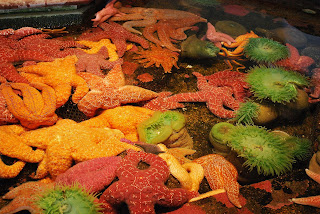“There is nothing very 'normal' about nature.”
Loren Eiseley
Not everyone knows what a sea star is, although everyone knows about starfish. Today's biologists and naturalists prefer the name sea star because these creatures are definitely not fish. Whatever you choose to call them, they are truly incredible beings.
These echinoderms ("spiny-skins") are finely adapted and perfectly structured to live where they do. Like snails and many other marine invertebrates, all sea stars begin life as tiny bits of free-swimming zooplankton which in no way resemble the adults. As they grow and mature, their bodies eventually take on the shape of their species and they migrate to the ocean floor where they spend the rest of their days.
Occurring in a variety of sizes and colors, they are all built similarly; instead of bones, their internal skeleton is made up of hundreds of thousands to millions of small calcium carbonate bits infused with tissue that are made into a living 3-dimensional box which forms the body of the sea star. These hard bone-like pieces (ossicles) often project through their skin forming the "spiny" part of their bodies. Because of this stiff internal structure, most are not terribly flexible, although they can slooowly bend and move enough to change position and get around as much as they usually need to. They definitely operate on "sea star time".
With their arms or rays extending out from a central disc, most have a body plan based on the number 5. We usually picture sea stars as having 5 arms, but some have 6, 10, or more.
Having an amazing ability to regenerate, if any of their arms are lost, they are able to grow them back - as long as at least a part of the central disc is intact. Because of this ability, they are of great interest to researchers within the medical community. Wouldn't it be wonderful if a human could grow back a missing limb?
On the underside of a sea star, long rows of tube feet extend down the length of each arm. They have literally thousands of these small suction cups and are able to control each and every one of them!
Basically, they use a rather sophisticated water hydraulic system which enables them to pump water into and out of each of these "feet" to extend and retract them as they wish.
This system serves them well, as they are able to open clams and other prey much easier than we could using only our bare hands. They don't need much of an opening for lunch, either. A gap of a few millimeters is all that's needed for them to extend their soft, bag-like stomach into the succulent clam and digest it.
The largest - and fastest-moving - species in the world occurs here in the Pacific Northwest. The Sunflower sea star can eventually reach 39 inches across and have 24 or so arms!
First, it develops five arms, adds one more directly opposite those, and then continues to add arms in sets of two, one on either side of the sixth arm, until they've reached their final number.
During one of our beach explorations, we tried an experiment by putting a cockle near a Sunflower star in shallow water. Nothing happened while we watched, but usually the cockle will "pole vault" away quickly, using its long, flexible foot to propel it.
Most of us only see sea stars in marine aquaria or on rocky shores during low tides.
"Tug on anything at all and you'll find it connected
to everything else in the universe."
John Muir
Interesting in learning more about sea stars?
Check these out:
http://www.seastarsofthepacificnorthwest.info/index.html
http://echinoblog.blogspot.com/2010/04/starfish-bones-understanding-evolution.html
Interesting in learning more about sea stars?
Check these out:
http://www.seastarsofthepacificnorthwest.info/index.html
http://echinoblog.blogspot.com/2010/04/starfish-bones-understanding-evolution.html














This is my kinda post! I learned something new about sunflower stars -- I didn't know about their approach to adding arms. Looking forward to more beachy posts from you as we move into summer.
ReplyDeletewow!! what a post!! i LOVE starfish...and learned a whole lot more just now...what beautiful pictures you've included too!!
ReplyDeletei've never even seen a picture of that Sunflower one before! wow!! so many arms!! thanks for all the info!!
Sherrie - I just learned about how the Sunflower Stars add their arms. Pretty amazing, although I do think all the sea stars are amazing! Yes, I spend a lot of time on the local beaches with my volunteer naturalist work, so I do hope to add more posts on the wonders found there.
ReplyDeleteLaura - glad to see you're "back in action" - I've missed you! I've been a bit out of it, too, but am bouncing back gradually. Glad you stopped by & enjoyed this post. I love to see all the critters you have down there in Florida, and I'm sure we have some beach life up here that's different from what you have. One of the great things about blogging, huh? One can travel the world without leaving home...